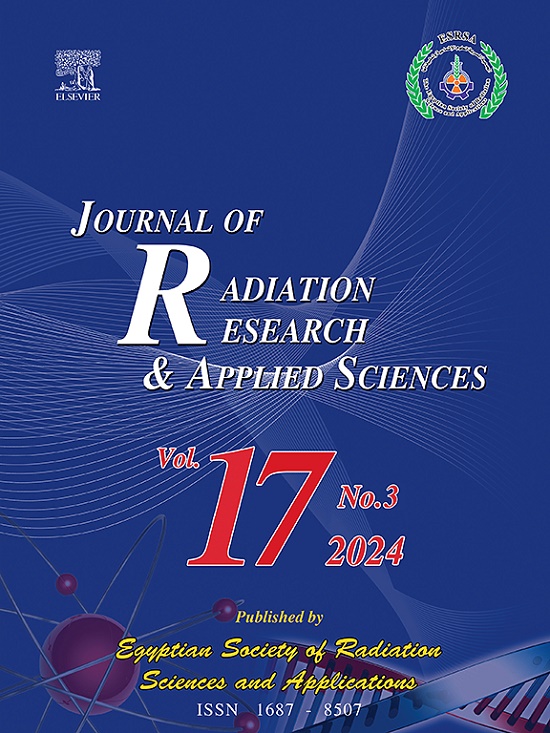Deep learning-based magnetic resonance imaging image reconstruction in the assessment of brain microstructural changes in Parkinson's disease patients
IF 2.5
4区 综合性期刊
Q2 MULTIDISCIPLINARY SCIENCES
Journal of Radiation Research and Applied Sciences
Pub Date : 2025-08-25
DOI:10.1016/j.jrras.2025.101876
引用次数: 0
Abstract
Objective
This study was aimed to investigate the application value of deep learning-based magnetic resonance imaging (MRI) image reconstruction technology in the assessment of brain microstructural changes in patients with Parkinson's disease (PD).
Methods
A total of 78 early-stage PD patients and 78 healthy controls were enrolled. Diffusion tensor imaging (DTI) was performed using MRI, and images were reconstructed using a multi-object interactive neural network-based brain MRI segmentation model. Parameters including fractional anisotropy (FA), mean diffusivity (MD), and radial diffusivity (RD) were calculated to assess microstructural changes in brain regions such as the substantia nigra, basal ganglia, and hippocampus. Pearson correlation analysis was employed to examine the association between regional parameters and Montreal cognitive assessment (MoCA) scores, while receiver operating characteristic (ROC) curves were used to evaluate the diagnostic efficacy of these parameters for PD.
Results
The constructed segmentation model achieved a Dice similarity coefficient (DSC) of 0.922, with relative volume difference (RVD) and root mean square (RMS) values of 0.042 and 0.46, respectively, outperforming related algorithms. The PD group exhibited significantly reduced FA and increased RD in the substantia nigra, hippocampus, and thalamus. Hippocampal RD demonstrated a strong negative correlation with MoCA scores (r=-0.67, P<0.001). ROC analysis indicated that hippocampal RD had the best diagnostic efficacy for PD [area under the curve (AUC) = 0.90, sensitivity 88 %/specificity 87 %], followed by substantia nigra RD (AUC = 0.88) and thalamic RD (AUC = 0.87).
Conclusion
Deep learning-based MRI reconstruction technology can accurately quantify early brain microstructural damage in PD patients. The RD of the hippocampus and substantia nigra are sensitive biomarkers for diagnosing PD and screen cognitive impairment, providing a new imaging strategy for the early precise diagnosis and treatment of PD.
基于深度学习的磁共振成像图像重建在帕金森病患者脑微结构变化评估中的应用
目的探讨基于深度学习的磁共振成像(MRI)图像重建技术在帕金森病(PD)患者脑微结构变化评估中的应用价值。方法入选早期PD患者78例,健康对照78例。利用MRI进行弥散张量成像(DTI),并利用基于多目标交互神经网络的脑MRI分割模型对图像进行重构。计算分数各向异性(FA)、平均扩散率(MD)和径向扩散率(RD)等参数,以评估黑质、基底节区和海马等大脑区域的微结构变化。采用Pearson相关分析检验区域参数与蒙特利尔认知评估(MoCA)评分的相关性,采用受试者工作特征(ROC)曲线评价这些参数对PD的诊断效果。结果所构建的分割模型的Dice相似系数(DSC)为0.922,相对体积差(RVD)和均方根(RMS)分别为0.042和0.46,优于相关算法。PD组在黑质、海马和丘脑中FA显著减少,RD显著增加。海马RD与MoCA评分呈显著负相关(r=-0.67, P<0.001)。ROC分析显示,海马RD对PD的诊断效果最佳[曲线下面积(area under the curve, AUC) = 0.90,敏感性88% /特异性87%],其次是黑质RD (AUC = 0.88)和丘脑RD (AUC = 0.87)。结论基于深度学习的MRI重建技术可以准确量化PD患者早期脑微结构损伤。海马和黑质RD是诊断PD和筛查认知障碍的敏感生物标志物,为PD的早期精确诊断和治疗提供了新的影像学策略。
本文章由计算机程序翻译,如有差异,请以英文原文为准。
求助全文
约1分钟内获得全文
求助全文
来源期刊

Journal of Radiation Research and Applied Sciences
MULTIDISCIPLINARY SCIENCES-
自引率
5.90%
发文量
130
审稿时长
16 weeks
期刊介绍:
Journal of Radiation Research and Applied Sciences provides a high quality medium for the publication of substantial, original and scientific and technological papers on the development and applications of nuclear, radiation and isotopes in biology, medicine, drugs, biochemistry, microbiology, agriculture, entomology, food technology, chemistry, physics, solid states, engineering, environmental and applied sciences.
 求助内容:
求助内容: 应助结果提醒方式:
应助结果提醒方式:


